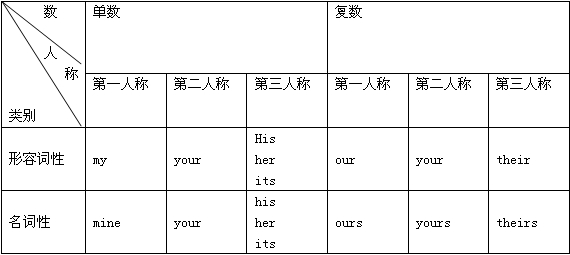He dropped his pen on ________ yesterday.[ ]A. my way to school B. your way home C. his way home D. him way home -八年级英语
题文
| He dropped his pen on ________ yesterday. |
|
[ ] |
| A. my way to school B. your way home C. his way home D. him way home |
答案
| C |
据专家权威分析,试题“He dropped his pen on ________ yesterday.[ ]A. my way to s..”主要考查你对 地点副词,物主代词 等考点的理解。关于这些考点的“档案”如下:
地点副词物主代词
考点名称:地点副词
- 地点副词:
表示地点的副词和表示位置关系的副词统称为地点副词。常见的这类副词有:
表示地点的:
here, there, home, upstairs, downstairs, anywhere, everywhere, nowhere, somewhere, abroad, elsewhere等。
表示位置关系的:
above, below, down, up, out, in, across, back, along, over, round, around, away, near, off, on, inside, outside, past等。
在表示位置关系的副词中,有些副词也可用作介词(如:above, over, beyond, around, below, down, up, in, along, near, off, on, past等),在没有宾语时就是副词,有宾语时就是介词,如:
Come in, please. (副词)
They live in the next room. (介词)
Let's take along. (副词)
Let's walk along this street. (介词)
She looked around. (副词)
They sat around the table. (介词)
Let's go on with the work...(副词)
What subject will you speak on? (介词) - 地点副词在句中的位置:
地点副词常放在动词后面,如果是及物动词,一般就放在宾语后面。如:
I remember having seen him somewhere.
Wuxia films are popular in China.
地点副词和时间副词并列使用时,一般要把地点副词放在时间副词之前。如:
We had a meeting here yesterday.
He did the work carefully here yesterday.
如果地点状语很长时,也可以放在时间状语之后。如:
He was born in 1940 in a small village at the foot of Mount Tai.
地点副词常可以用作表语:
副词可以用作表语,主要是地点副词,时间副词和其他副词有时也可以用作表语。如:
They are inside. 他们在里面。
How long will she be away? 她要离开多久?
When will you be back? 你什么时候回来?
You haven't been around much. 你很少到这边来。
He'll be round in an hour. 他一个小时内就到。
Now autumn is in. 秋天来了。
I must be off now. 我得走了。
We are behind in our plan. 我们落在计划后面了。
考点名称:物主代词
- 物主代词:
表示所有关系的代词叫做物主代词,也叫人称代词的所有格。
物主代词分为形容词性物主代词和名词性物主代词两种。
物主代词有人称和数的变化。第三人称单数的物主代词还有性别的变化。 物主代词的用法:
物主代词既有表示所属的作用又有指代作用,例如:
John had cut his finger; apparently there was a broken glass on his desk.
约翰割破了手指,显而易见,他桌子上有个破碎的玻璃杯。
物主代词有形容词性(my, your等)和名词性(mine, yours等)两种:
形容词性的物主代词属于限定词。
名词性的物主代词在用法上相当于省略了中心名词的 -'s属格结构,例如:
Jack's cap 意为 The cap is Jack's.
His cap 意为 The cap is his.形容词性物主代词用法:
1. 形容词性物主代词相当于形容词,在句中只能用作定语,后面必须跟名词。名词性物主代词常用来避免和前面已提及的名词重复。
相当于【形容词性物主代词+名词】。例如:
Is that yourbike? 那是你的自行车吗?
My pen is quite different from his.
2. 如果名词前用了形容词性物主代词,就不能再用冠词(a, an, the)、指示代词(this, that, these, those)等修饰词了。例如:
这是他的书桌。This is his desk.
3. 与形容词一起修饰名词时,形容词性物主代词要放在形容词的前面。例如:
his English books他的英语书。
their Chinese friends他们的中国朋友。
4. 汉语中经常会出现"我妈妈","你们老师"等这样的语言现象,虽然代词用的是"我"、"你们",但实际意义仍是"我的"、"你们的",
所以在英译时,注意要用形容词性物主代词"my","your"。
例如:你妈妈在家吗?
误:Is you mother at home?
正:Is yourmother at home?
5. it's与its读音相同,he's与his读音相似,但使用时需注意它们的区别(it's和he's分别是it is和he is的缩略形式,但its 和his 却是形容词性物主代词) 。
例如: It's a bird. Its name is Polly. 它是一只鸟。它的名字叫波利。
He's a student. His mother is a teacher. 他是一名学生。他妈妈是一位教师
口诀:
有“名”则"形“,无“名”则“名”。
意思是:后面是名词的话,前面就要用 形容词性物主代词。后面没有名词的话,就用名词性物主代词。名词性物主代词的句法功能:
a. 作主语,例如:
May I use your pen? Yours works better.
我可以用一用你的钢笔吗? 你的比我的好用。
b.作宾语,例如:
I love my motherland as much as you love yours.
我爱我的祖国就像你爱你的祖国一样深。
c.作介词宾语,例如:
You should interpret what I said in my sense of the word, not in yours.
你应当按我所用的词义去解释我说的话,而不能按你自己的意义去解释。
d.作主语补语,例如:
The life I have is yours. It's yours. It's yours. 我的生命属于你,属于你,属于你。
名词性物主代词可以用在介词of的后面,相当于“of+名词所有格”。
口诀
有“名”则"形“,无“名”则“名”。
注:
后面是名词的话,前面就要用 形容词性物主代词。
后面没有名词的话,就用名词性物主代词.形容词性物主代词与名词性物主代词的区别:
一.形容词性物主代词起形容词的作用,用在名词前。
例:
1. This is my book.这是我的书。
2. We love our motherland.我们热爱我们的祖国。
二.名词性物主代词起名词的作用。
例:
1. Look at the two pencils. The red one is yours and the blue one is mine.
看那两支铅笔,红的是你的,蓝的是我的。
2. He likes my pen. He doesn't like hers.
他喜欢我的钢笔。不喜欢她的。
3. 注意:在使用名词性物主代词时,必须有特定的语言环境,也就是要省略的名词。
例:
It's hers.是她的。
(单独使用大家不知是怎么回事,不可以这样用)
There is a book. It's hers.那有本书。是她的。
(先提及,大家才明白)
4. 名词性物主代词=形容词性物主代词+名词
为避免重复使用名词,有时可用“名词性物主代词”来代替“形容词性物主代词+名词”的形式。
例:
My bag is yellow, her bag is red, his bag is blue and your bag is pink.
为避免重复使用bag,可写成My bag is yellow, hers is red, his is blue and yours is pink.物主代词“形”变“名”歌:
形物代变名物代
掌握规律变得快
多数词尾加-- s
my,its,his要除外
my把y来变成i
接着再把 ne 带
his,its 不用变
词形一样莫奇怪
- 最新内容
- 相关内容
- 网友推荐
- 图文推荐
| [家长教育] 孩子为什么会和父母感情疏离? (2019-07-14) |
| [教师分享] 给远方姐姐的一封信 (2018-11-07) |
| [教师分享] 伸缩门 (2018-11-07) |
| [教师分享] 回家乡 (2018-11-07) |
| [教师分享] 是风味也是人间 (2018-11-07) |
| [教师分享] 一句格言的启示 (2018-11-07) |
| [教师分享] 无规矩不成方圆 (2018-11-07) |
| [教师分享] 第十届全国教育名家论坛有感(二) (2018-11-07) |
| [教师分享] 贪玩的小狗 (2018-11-07) |
| [教师分享] 未命名文章 (2018-11-07) |



![I'll go __________ to do __________ homework.[ ]A. to home; myB. home; myC. to home; meD. to home; I-七年级英语](http://www.00-edu.com/d/file/ks/4/2/didianfuci/2019-12-31/smalleb59343d82efd60e98202c9f78a960ac1577805014.jpg)


